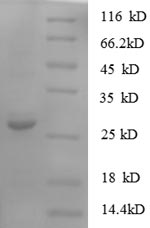Recombinant Human Protein S100-A11 (S100A11) gets expressed in E. coli and spans the full length of the mature protein from amino acids 2 to 105. The protein carries an N-terminal 6xHis-SUMO tag to help with purification and detection. SDS-PAGE analysis shows purity levels above 90%, which appears to deliver reliable results for research work. This product is meant for research use only.
S100A11 belongs to the S100 protein family and is known for its calcium-binding capabilities. The protein seems to play a role in both intracellular and extracellular regulatory activities, taking part in pathways that control cell growth and differentiation. Researchers studying cellular processes and signal transduction often find S100A11 particularly interesting, given its involvement in multiple cellular pathways.
Potential Applications
Note: The applications listed below are based on what we know about this protein's biological functions, published research, and experience from experts in the field. However, we haven't fully tested all of these applications ourselves yet. We'd recommend running some preliminary tests first to make sure they work for your specific research goals.
Human S100A11 is a calcium-binding protein that requires precise folding, proper EF-hand formation, and calcium-dependent conformational changes for its functional activity. The E. coli expression system can produce soluble proteins but may not support the calcium-binding functionality without proper metal ion incorporation. The N-terminal 6xHis-SUMO tag (∼15 kDa) is large relative to the small S100A11 protein (∼12 kDa) and may sterically interfere with its functional domains or dimerization interfaces. While the protein may be soluble, the probability of correct folding with functional calcium-binding and dimerization activity requires experimental validation.
1. Protein-Protein Interaction Studies Using Pull-Down Assays
This application carries a significant risk without proper folding and calcium-binding validation. S100A11 interactions are often calcium-dependent and require precise tertiary structure. If correctly folded and functional (verified), the protein may identify physiological partners. If misfolded/unverified, there is a high risk of non-specific binding or failure to replicate genuine interactions. The large SUMO tag may sterically block binding interfaces.
2. Antibody Development and Validation
This application is highly suitable as antibody development relies on antigenic sequence recognition rather than functional conformation. The full-length mature protein provides comprehensive epitope coverage for generating S100A11-specific antibodies. The high purity (>90%) ensures minimal contamination-related issues.
3. Biochemical Characterization and Structural Studies
These studies are essential for determining folding status. Techniques should include circular dichroism spectroscopy to assess secondary structure, size-exclusion chromatography to evaluate dimerization, and calcium-binding assays to validate functionality. However, the large SUMO tag may dominate biophysical properties and interfere with structural studies.
4. In Vitro Functional Assays and Enzyme Activity Studies
This application requires rigorous functional validation. S100A11's activity depends on calcium-binding and proper dimerization. If correctly folded and active (verified), limited functional studies may be possible. If misfolded/inactive (unverified), assays will yield biologically misleading results. The SUMO tag may interfere with functional interactions.
Final Recommendation & Action Plan
The E. coli-expressed S100A11 with a large SUMO tag poses challenges for functional applications due to potential steric interference and uncertain calcium-binding capability. Begin with Application 3 (Biochemical Characterization) to assess folding quality through CD spectroscopy, SEC (dimerization analysis), and validate calcium-binding functionality. Applications 1 and 4 require rigorous functional validation before proceeding. Application 2 (antibody development) can proceed immediately. Consider SUMO tag removal for critical functional studies to minimize interference. Always include calcium-binding controls and validate key findings with tag-free or mammalian-expressed S100A11 when possible.






